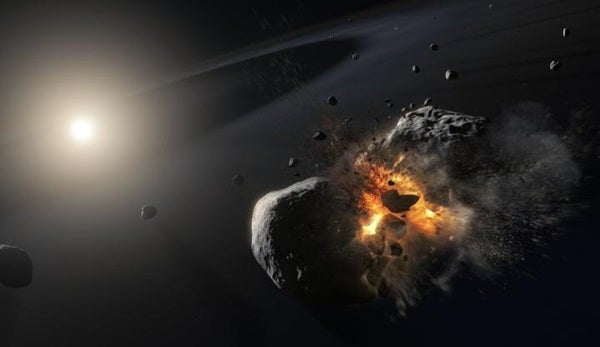In the years that followed, researchers used the Hubble Space Telescope to check in on the suspected distant world, which orbits more than 100 times farther from its star than the Earth does from the Sun. For a while, they saw it trundle through its orbit. Then, in 2014, it disappeared.
The new findings were published in the Proceedings of the National Academy of Sciences.
“These collisions are exceedingly rare, and so this is a big deal that we actually get to see one,” said lead author András Gáspár, an astronomer at the University of Arizona, in a statement. “Our study, which analyzed all available archival Hubble data on Fomalhaut b, including the most recent images taken by Hubble, revealed several characteristics that together point to a picture that the planet-sized object may never have existed in the first place,” he added.
A strange planet
Though initially thought to be a planet, as the years passed, astronomers started noticing that Fomalhaut b wasn’t acting like other exoplanets they’ve discovered.
For one, the planet could be seen directly. Normally, exoplanets are too small and cool to reflect or emit enough light to be visible from Earth. To counter this odd attribute, some astronomers proposed that Fomalhaut b might have a shell or ring of dust around it, which could explain its surprising brightness. But then there was the fact that Fomalhaut b was continuously fading over time, which is unusual.

Want to learn more about pulsars and other extreme objects in our universe? Check out our free downloadable eBook: Exotic objects: Black holes pulsars, and more.
The last straw for Fomalhaut b was when researchers looked at Hubble images from 2014, which revealed the object had vanished altogether. Though there could be reasons why an exoplanet fades, they certainly don’t just disappear.
This led researchers to conclude that Fomalhaut b was nothing more than a planetary mirage — namely, an energetic cloud of debris blasted from a collision between two large icy objects. Then, as the cloud dispersed, the faux-planet Fomalhaut b dissolved into nothingness. Based on the evolving shape and location of the debris, the researchers estimate the original colliding bodies were each likely a mix of ice and dust measuring about 125 miles (200 kilometers) across.
Unfortunately, Hubble seems to have been late for the main event, as the researchers think the crash happened right before the telescope began observing the system in 2004. But just detecting the results of such a violent cosmic event is exciting, they say. According to the researchers’ calculations, such a massive collision may only happen once every 200,000 years in a given system.
Astronomers hope to further study the Fomalhaut system with the upcoming the James Webb Space Telescope during its first year of operations. The future observations will hopefully answer questions about Fomalhaut’s asteroid belt, as well as about any legitimate planets actually orbiting the star.










